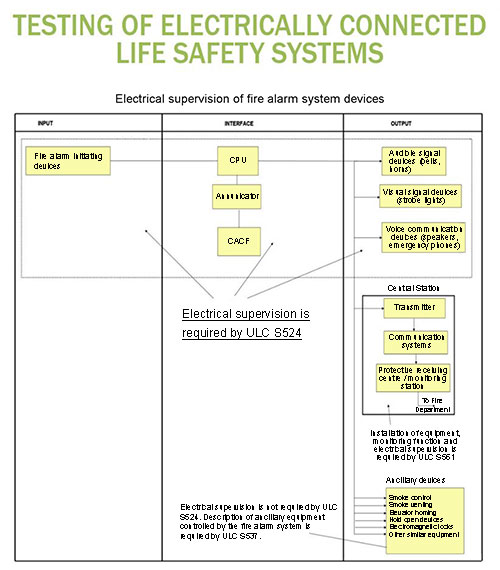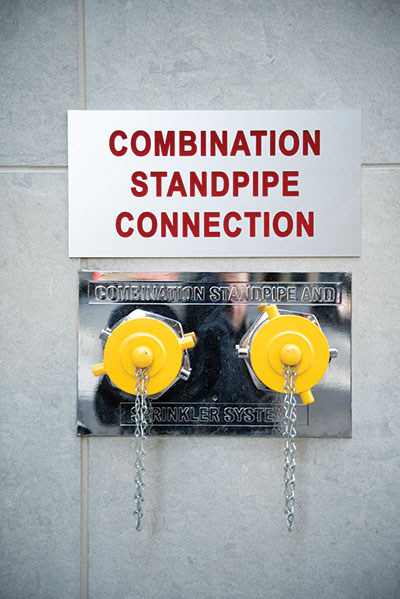The subjects of Integrated fire protection and life safety systems should not be new to the electrical designers, contractors and regulators, as the requirement to commission integrated fire protection and life safety systems was originally placed into Article 3.2.4.6. of the National Building Code of Canada (NBCC) in 2010.
2015 edition of the NBCC has removed the requirement for commissioning of integrated fire protection and life safety systems from Subsection 3.2.4. (i.e., Subsection of the NBCC which applies to fire alarm systems and smoke alarms only) and placed such test requirement into the new, stand-alone Subsection 3.2.9. This decision was based on the fact that these integrated electrically connected systems are not limited to fire alarm and voice communication systems, but include many other components such as fire signal receiving centers, standpipe and sprinkler systems, electrically connected exit signs, emergency lighting, emergency generators and automatic transfer switches, fire pumps, elevators emergency recall feature, dampers and fans of smoke control and smoke venting equipment, hold open devices, fire shutters and electromagnetic locks. Why do electrical designers, installers, and regulators have to know about such integrated life safety systems and testing of their operations? The answer is simple: electrical designers show these systems and appropriate interlocks between them in their design, electrical contractors install and interconnect these systems, and electrical safety regulators are involved in a coordinated inspection of these systems – to ensure that the safety and performance requirements of applicable codes are not compromised.
Let’s review Subsection 3.2.9. and Article 3.2.9.1. of the NBCC 2015 and the explanatory Appendix A Note on this Article.
Subsection 3.2.9. of the NBCC offers the following requirement on this subject:
“3.2.9. Integrated Fire Protection and Life Safety Systems
3.2.9.1. Testing
1) Where fire protection and life safety systems and systems with fire protection and life safety functions are integrated with each other, they shall be tested as a whole in accordance with CAN/ULC-S1001, “Integrated Systems Testing of Fire Protection and Life Safety Systems,” to verify that they have been properly integrated. (See Note A-3.2.9.1.(1).)”
The NBCC explanatory Note in Appendix A on this requirement provides the following clarification:
“A-3.2.9.1.(1) Testing of Fire Protection and Life Safety Systems. Building owners should verify that fire protection and life safety systems and their components (i.e. fire alarm systems, sprinklers, standpipes, smoke control, ventilation, pressurization, door hold-open devices, elevator recalls, smoke and fire shutters and dampers, emergency power, emergency lighting, fire pumps, generators, etc.), including their interconnections with other building systems, are functioning according to the intent of their design.
CAN/ULC-S1001, “Integrated Systems Testing of Fire Protection and Life Safety Systems,” provides the methodology for verifying and documenting that interconnections between building systems satisfy the intent of their design and that the systems function as intended by the Code.
Clause 6.1.5 of CAN/ULC-S1001 allows the Integrated Testing Coordinator to accept documented evidence of any tests that have been performed on a system as part of its acceptance testing for the purpose of demonstrating compliance with the integrated testing requirements of that standard, so as to avoid duplication of work”.
It is interesting to note a slight difference between the requirement of Article 3.2.4.6. in the 2010 edition of the NBCC and the provision of Article 3.2.9.1. in the 2015 edition of the building code. 2010 NBCC (which is currently used as a seed document for all legally adopted provincial/territorial building codes and municipal building by-laws) considers such testing of integrated life safety and fire protection systems as “commissioning”, and emphasizes that the commissioning procedure is required in order to comply with the NBCC or with the National Fire Code (NFCC).
2015 edition of the NBCC treats such coordinated activity as “Testing of Fire Protection and Life Safety Systems“, states that this testing must comply with ULC standard S1001 and does no longer reference the NFCC.
Does this change mean that the approach to testing of integrated fire protection and life safety systems has been changed? Not really. The wording of the NBCC 2015 correlates this procedure with the title of ULC S1001, the standard that was published only in 2011, which describes this procedure as “testing” rather than “commissioning”. Although this NBCC 2015 requirement does not reference the NFCC for a need to provide testing of the operational integrated fire protection systems in the existing buildings, this fact also does not mean that testing of the existing systems is no longer required. The building owners would have to be responsible for ensuring that such testing of integrated electrically connected fire protection/life safety systems is performed in accordance with the applicable provisions of the NFCC after the occupancy permit has been issued, and when all integrated fire protection and life safety systems would have to be maintained and tested as required by the NFCC.
And the essence of this testing remains the same whether the newly installed integrated systems are tested prior to the issuance of the building occupancy permit in accordance with the NBCC or whether such testing is performed on already existing systems in occupied buildings – to ensure that they function as originally designed.
The diagram below illustrates how some of such electrically connected fire protection and life safety systems (i.e., release of electromagnetic locks and hold-open devices on doors, automatic recall of elevators, automatic activation of smoke control and smoke venting dampers and fans and sending signals to fire receiving centers) are initiated by a building fire alarm system.

Chart 1. Testing of Electrically Connected Life Safety Systems














Find Us on Socials